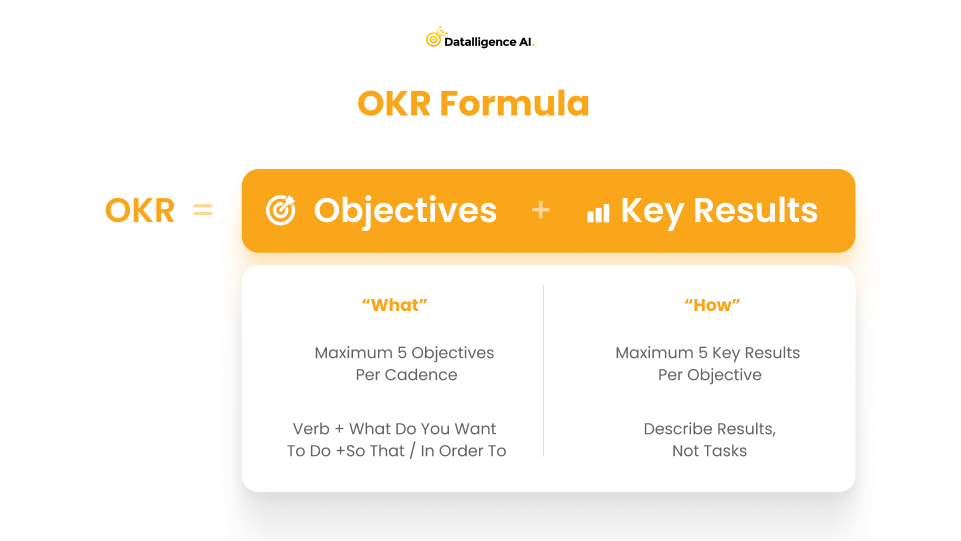Before discussing how to write OKRs, we will have a little introduction on what OKRs is.
OKRs are Objectives and Key Results initiated by Andy Grove in 1954 and later introduced to google by John Doerr in 1999
OKRs are a goal-setting framework that helps organizations to measure organizational and people performance. An agile framework that helps many organizations to achieve their aspirational and audacious goals.
OKR aligns the team and individual objectives to the organizational objective. OKRs create focus by limiting the objectives and increases accountability amongst the team.
They are transparent and flexible.
How to unveil the art of writing OKRs?
When we start with how to write an OKR, there is a simple formula to it.
Objectives – Objectives are the goals or the destination
Key Results – Key results helps us reach our goal or destination with a measurable target and timeline.
When we add both together that becomes powerful in writing OKRs
Keep your Objectives to three
While you are in the journey of building OKRs, we must have OKRs not more than 3 per quarter, Less is more.
Keeping the objective numbers as three will help us to prioritize what is necessary for the immediate quarter and what is achievable in that said time. This will avoid making mistakes in thinking all our objectives are our priorities. Objectives are typically monthly and quarterly. We recommend a quarterly cadence.
Few OKR Writing Tips

- The objective should start with a verb and use the formula to make it simple
Verb + what do you want to do + so that / in order to
- Objectives should be Directional else it can be ambiguous while setting Key Results
- Objectives are not the Status Quo of the organizations (E.g.: Maintain Sales revenue of XXX Billion).
- Keep it aligned to your organization’s objectives. There are ways to align objectives. With Datalligence you can either
- Align your objectives to a company objectives
- Align to a team objective, which in turn aligned with the company objective.
- Create an individual objective which can personal development goals
- Ensure that the Objective written creates an impact on the company objectives or a team objective. Aligning an objective with no impact is mostly not recommended
- It is necessary that the objective has to be time-bound, indefinite Objectives will not serve the organizational purpose.
- A big no to the metrics for Objective, that will be taken care of by the Key results.
- Keep it in simple language that can be understood by people across the organization and across all levels
Writing Key Results
Connect your objectives with the Key Results which have a definitive target. We also recommend a binary sometimes to drive results stringently. This in turn easily gives us an understanding of where we stand and how do we control or accelerate the progress. Key results are highly recommended to have metric targets to have a clear vision.
Keep the Key Results to five or less
We recommend having 3 to 5 key results. Adding more Key Results to an objective will also divert the focus. We tend to spend more time on a Key Result that has less priority.
Key results work as your navigation guideline to understand where we are and what is our outcome. If you have an inspirational and audacious then the key results should be written in such a way that it drives the objective.
Key Result writing tips
- Identify what really matters to achieve the objective
- We get tempted to add too many Key results, keep it simple and restrict within 5
- Do not confuse your task with the Key Results. Tasks are just To-Dos.
- Keep the Objective, objective not subjective. There should be a clear indication of the target or an outcome.
- Keep a metric-driven can have both start value and end value. (Eg. Increase the engagement score from 5 to 8)
- With the Datalligence platform you can create
- Positive Metric
- Negative Metric
- Health Metric
- Milestone Metric
Few tips to follow
- Let the team and the individual take the initiative in creating OKRs
- It is OK to fail, keep the team understands that we are all together on this and we sail together, no matter what.
- Fine to rewrite the OKRs if it doesn’t help you achieve the goal.
- Grade the Key results in the decided intervals
- Be courageous to set stretch Goals
Conclusion
Writing OKRs are a key to start the journey and it can be achieved easily and with no ambiguity, the tool guides you to create your own OKRs. Align and track seamlessly with Datalligence OKR platform. If you are curious to learn more about OKRs, write to us and we can together write your OKRs.










